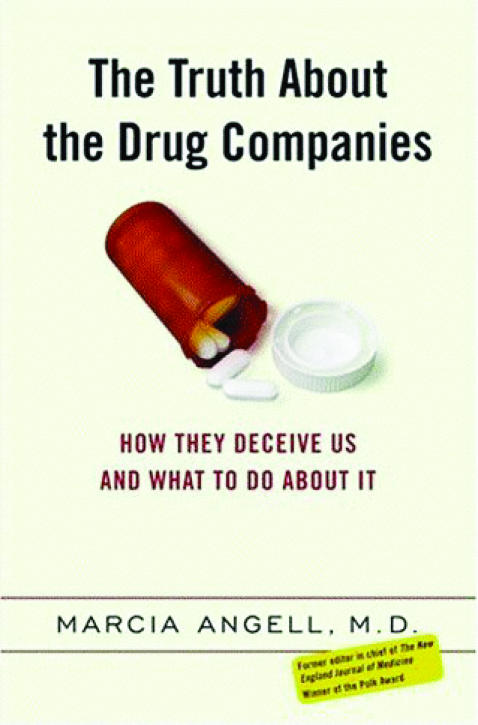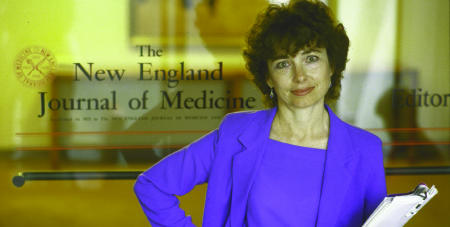Dr Marcia Angell, a member of Harvard Medical School's Department of Social Medicine, has written a painstakingly researched book on the wiles and ways of what has come to be called “big pharma.” It is a clear exposé of the American drug industry and is written in the impassioned but impeccable prose we expect from a former editor of the New England Journal of Medicine.
Figure 1.

Marcia Angell
Random House, $24.95, pp 336 ISBN 0 375 50846 5 Also available as an ebook, $17.95 www.randomhouse.com
Rating: ★★★★
Angell says that $200bn (£110bn; €165bn) is spent annually on prescription drugs in the United States. With the cost rising 12% a year, it is the fastest growing part of America's swollen health bill. In 2002 the average price of the 50 commonest drugs used by elderly people was nearly $1500 for a year's supply. At, say, six prescriptions—not an uncommon number among elderly Americans—that's $9000 a year for one person's drugs. What are the remedies for this unaffordable financial burden? Choose between food, fuel, or drugs? Take half doses? Take a trip to Canada to buy cheaper drugs? Or ignore your doctor's prescriptions altogether?
To deal with this dilemma the US Congress passed the Medicare Reform Bill at the end of 2003, with a drug benefit to begin in 2006—but this is already inadequate, as it's been overtaken by sharply rising costs.
Angell says that public resentment and resistance to these consumer rip offs has been growing. Big pharma's response has led not to drug discounts but to public relations ploys justifying bloated prices, mainly involving the three marketing mantras: research, innovation, and free enterprise in the interests of shareholders. She points out that the United States is the world's major profit centre for drugs. Big pharma relocates here from other countries “to feed on the unparalleled research output of American universities and the [taxpayer funded] National Institutes of Health.”
For two decades the drug industry was the most profitable sector; even in 2003 it came third, behind crude oil and banking. But now, Angell says, it is facing “a tidal wave of government investigations and civil and criminal lawsuits.”
She writes, “The litany of charges includes illegally overcharging Medicaid and Medicare, paying kickbacks to doctors, engaging in anticompetitive practices, colluding with generic companies to keep generic drugs off the market, illegally promoting drugs for unapproved uses, engaging in misleading direct-to-consumer advertising, and, of course, covering up evidence. Some of the settlements have been huge.”
The book's 13 chapters examine the drug industry's exaggerated claims of producing new drugs and its barrage of media marketing disguised as consumer education. Actually, big pharma's main business is in producing what are called “me too” drugs: merely variations of old drugs created to prolong patent rights and to grab market share.
Figure 2.
Dr Marcia Angell: her exposé of big pharma is an important public service
Credit: STEVE LISS/TIME LIFE/GETTY
Angell remembers the philosopher Immanuel Kant: “Physicians think they do a lot for a patient when they give his disease a name.” And she writes, “As the whole world knows, there is now a condition recently christened `erectile dysfunction,' and a drug, Viagra [sildenafil], and two me-toos, Levitra and Cialis, to treat it. Advertisements for these drugs feature not decrepit old men but young athletes. The implication is obvious. Any episode of impotence, no matter how rare and how mild, is `erectile dysfunction,' there is a pill for it, and if this macho quarterback is not too embarrassed to ask for it, you don't have to be either.”
Less profitable drugs—those against malaria and tuberculosis, for example—receive much less attention. The Bush administration, friendly to big pharma, “has refused to allow any of the promised $15bn in federal funds allotted for HIV/AIDS treatment in the Third World to be spent on generic drugs.”
Among the many wiles exposed are big pharma's use of contract research organisations to exert undue influence over clinical research and its insidious seduction of doctors. In 2001 drug companies gave doctors nearly $11bn worth of “free samples.” This was in addition to the “food, flattery, and friendship” provided by drug company representatives to doctors (BMJ 2003;326: 118912775621).
The final chapter, “How to Save the Pharmaceutical Industry—And Get Our Money's Worth,” gives seven essential reforms, chief of which is for the Food and Drug Administration to compare new drugs not with placebos but with old drugs, to see whether there are any additional benefits.
Angell's goal is access to good drugs at reasonable prices, which requires public pressure to spur the government to action against big pharma's powerful and ubiquitous lobbyists (more numerous than the members of Congress) and its political campaign contributions. She has performed an important public service in focusing on the drug companies and their disingenuousness. The reform of big pharma starts with a public outcry against the abuses she has shown. And here doctors should stand by their patients, not their purses.
Items reviewed are rated on a 4 star scale (4=excellent)



